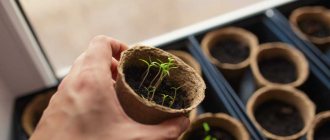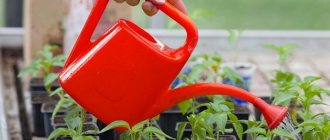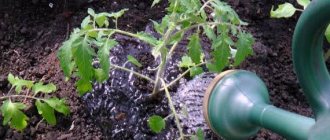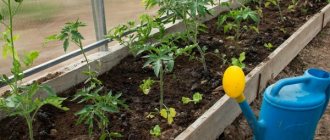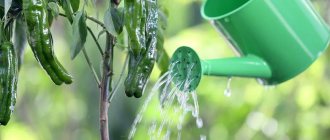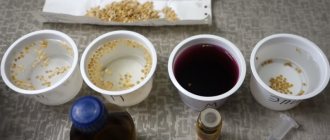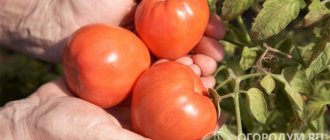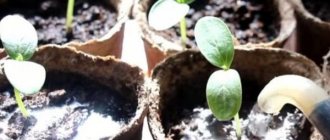How often to water tomato seedlings
The question is far from idle, and some gardeners are faced with a problem when tomato seedlings begin to break at the base and fall. The problem lies in waterlogging of the soil.
Tomatoes are a drought-resistant crop. Its root can go 1.5 m deep into the soil, and naturally there is always moisture there. Therefore, tomato seedlings in open ground are watered rarely, but abundantly. Things are somewhat different when grown at home.
On average, seedlings are watered once every 4-5 days in sunny weather and increase the interval to 6-8 days on cloudy days.
Of course, soil structure plays an important role. Moisture evaporates from a light and loose substrate much faster, which means watering should be more frequent.
After planting the seeds
How to determine whether plants need irrigation? At the stage of seed germination, gardeners try to create optimal conditions for this. Stretch plastic film over the seedling boxes, cover them with glass, or use purchased mini-greenhouses equipped with transparent plastic lids.
In such conditions, additional moisture is rarely required. But in case of doubt, the surface is wetted with a spray bottle.
After germination
After the appearance of mass shoots, the shelters are removed, but no watering is carried out. There is still moisture in the soil that was introduced when sowing the seeds, and the roots will be drawn to it, gaining volume and strength. And after 3-5 days the sprouts should be watered. Small containers are watered with a teaspoon, syringe and even a pipette.
But when growing a large volume of seedlings, such methods are not suitable. A small watering can with a long spout works best.
It is good if seedlings are grown in transparent containers where the condition of the soil can be seen.
For plastic and wooden seedling boxes, you can use a simple device:
- Make a hook from a piece of strong wire (15-20 cm), bending it 1-2 cm in length.
- The device is immersed in the soil along the wall of the vessel to the base, slightly turned and removed.
- By kneading the caught lump in your fingers, you can determine whether to water it now or postpone the procedure for a day or two.
However, it should be noted that this method is applicable only to very young seedlings, when the root system has not yet entwined the earthen ball. It is during this period that there is the greatest risk of soil waterlogging, which leads to blackleg disease.
In any case, all planting containers must be equipped with drainage holes. As soon as water begins to ooze from them, it means that the earth is saturated with moisture.
As the seedlings grow, the need for water increases. Seedlings ready for picking are watered a day or two before this procedure. It is necessary that the soil dries out a little and during work easily separates from the roots without causing harm to them.
The sprouts are also planted in moist soil, accompanied by light watering. This is necessary so that the thin threads of the root system are in close contact with the ground.
How to water tomato seedlings after diving
Correctly carried out picking of tomato sprouts will provide them with the necessary level of humidity for the first 4-6 days. At this time, the boxes with seedlings are somewhat shaded so that rooting takes place more calmly. Further watering is carried out at approximately the same frequency.
For watering, it is advisable to use a small watering can with a long narrow spout; such equipment can easily be placed between tomato bushes.
- If seedlings are grown in individual containers, then water is slowly poured closer to the walls of the vessel. It is necessary to ensure that the root system is not exposed. If necessary, add soil to the cups.
- In common boxes, seedlings are watered between the rows, preventing water from getting on the leaves.
The sun's rays falling from the window can cause them to burn. Therefore, it is recommended to water tomato seedlings grown at home either in the evening or early in the morning.
And 2 weeks after the dive, watering is combined with fertilizing. The choice of fertilizer depends on the location of the seedlings. It is unlikely that a gardener will want to plant an infusion of mullein or bird droppings in an apartment. Although this is the best option for the first feeding, it is still better to use it in greenhouses.
At home, you can use an infusion of wood ash (1 tablespoon per 1 liter of water). Tomatoes respond very well to this natural fertilizer.
Among the industrial preparations used:
- "Agricola";
- "Intermag vegetable garden";
- "Gumi Kuznetsova";
- "Ideal";
- "Baikal EM 1".
Specialized stores offer a very wide selection of mineral fertilizers for feeding tomato seedlings.
When applying fertilizer, you need to be careful and not allow the solution to get on the leaves. If this happens, wash it off using a spray bottle. Fertilizing is done on moist soil, spending 100-120 ml per plant.
The gardener will have to take care of the soil moisture in the seedling boxes for more than 2 months. At this age, the tomato bushes will be ready to be transplanted into open or protected ground.
Before planting in open ground, seedlings are hardened for 2 weeks, and a few hours before the planned work, they are watered, but not to the point of dirt. The next watering will be carried out in a permanent place: in an open-air garden bed or in a greenhouse.
Watering after picking
About three days before the planned picking of tomatoes, the seedlings are watered at home. You should water the tomatoes very generously so that the soil mixture becomes deeply moistened.
After this, the seedlings are no longer watered from above. Is it possible to water through a tray? It is even necessary to water through a tray. This way you can force the roots of the sprouts to stretch deeper, which means they will become stronger and the plants will be able to develop a powerful root system.
After picking, the stronger tomatoes begin to be watered again at the root as the substrate dries. You need to use only settled warm water and try not to get it on the leaves when watering.
Subsequently, the tomatoes are watered in the usual way until they are planted in the ground as needed.
Watering tomato seedlings
Folk fertilizers are not inferior in efficiency to industrial fertilizers, but at the same time they cost almost nothing. Recipes inherited by summer residents from previous generations pass from mouth to mouth and help to grow strong and healthy seedlings.
Iodine
Experts have not thoroughly studied the effect of iodine on the plant, but the positive effect of using such fertilizing has long been confirmed experimentally. The element does not directly affect the growth processes of tomatoes, but is a catalyst for the absorption of nutrients and helps strengthen the immune system. In the case of seedlings, iodine is used only until the ovaries appear. After its influence, plants develop better, get sick less, and subsequently produce a bountiful harvest.
It is important to follow the correct dosage of iodine fertilizer. In large quantities, the substance has a toxic effect on plants. It is recommended to water the seedlings with water with the addition of iodine 7 days after the first fertilizing with mineral complex fertilizer. To prepare the solution, 1 drop of iodine is dissolved in 3 liters of water. You need to water the seedlings with this product through a strainer, irrigating the leaves and the top layer of soil.
On a note! Before planting the seedlings in a permanent place, the soil is watered with an iodine solution prepared in the same proportion as for watering the seedlings. This will disinfect the soil and help the plants take root better. This manipulation should be carried out a day before the transplant.
Yeast
Yeast contains a lot of substances beneficial to plants and additionally improves the soil structure after application. Under the influence of the yeast solution, the growth rate of tomatoes increases, disease resistance improves, and productivity increases.
This fertilizing can be used at any stage of crop cultivation, but it is better to start doing this at the seedling stage. Yeast has an equally good effect on the development of the above-ground and underground parts of seedlings, helping them become stronger and recover faster after picking. Yeast does not cause any harm to the soil and plants, so you can safely use it.
To prepare the solution, use 50 g of fresh yeast or 5 g of dry yeast per 5 liters of water. Additionally, you can add 1 tbsp. spoon of sugar. All ingredients must be mixed and the mixture allowed to brew for 2-3 hours. Before use, the fertilizer is diluted in a ratio of 1:5.
Hydrogen peroxide
Hydrogen peroxide is used to stimulate the growth of tomato seedlings and prevent diseases. The product disinfects the soil well and prevents the proliferation of pathogenic microorganisms in it. Peroxide, as peroxide is also called, helps fill the roots with oxygen and neutralizes nitrates contained in the soil.
After watering with peroxide, iron and manganese salts that are useful for tomatoes are restored in the soil. The first feeding is carried out 2-3 weeks after emergence. In the future, the plants are watered with the product once a week. To prepare the fertilizer, mix 1 tbsp. spoon of hydrogen peroxide with 1 liter of water. The composition must be prepared immediately before use; it cannot be stored.
Watering after planting
A couple of days before planting the seedlings in the ground, watering is stopped. Then, a couple of hours before planting, the tomatoes are well filled with water to soak the roots and injure them less. When planting, the seedlings are also well moistened, and the soil around each bush must be mulched to reduce moisture evaporation.
Tomato seedlings grown on a windowsill indoors are very vulnerable. That is why in the middle zone gardeners often plant it in a greenhouse. The rules for watering plants after planting in the ground change, but, in general, gardeners adhere to the main rule of watering seedlings - it is necessary to moisten the soil as it dries.
After planting, seedlings should not be watered for two weeks. Next, very abundant watering is carried out. For each bush you need to spend about 10 liters of water. The frequency of watering should be moderate, as this crop does not tolerate dampness. It is enough to water the planted tomato seedlings once a week.
When watering, you should not pour water on the tops, as this will inevitably lead to disease. Most often, tomatoes suffer from late blight, which occurs precisely because of excessive dampness.
How to make drip watering of tomato seedlings on a windowsill with your own hands
Drip watering of tomato seedlings on the windowsill is very convenient. This method allows you to deliver moisture to plants literally drop by drop, simultaneously avoiding dryness and waterlogging of the soil. You can make your own drip irrigation system using plastic bottles and dropper tubes equipped with a clamp.
The container with water will need to be placed above the container with the seedlings, on a small stand or shelf. The tube from the injection system is connected at one end to the bottle, and the other end is inserted into the ground to a depth of several centimeters. The water supply speed is controlled by a clamp. The method is convenient in that you can moisten several containers with seedlings from one bottle at once, without spending additional time and effort.
How to determine the sufficient level of soil moisture
In general, the optimal humidity level for tomato and pepper seedlings is 65-70%. But it is simply impossible to determine this manually - you need to use special equipment, which not every summer resident has.
Therefore, you should remember a simple rule - it is better to underfill than to overfill. As soon as the seedlings take on a limp appearance - the stem bends, the leaves droop - it’s time to moisten the soil. By remembering how often the seedlings are watered and how much water is consumed, you can easily deal with the issue and prevent a lack or excess of moisture.
Watering seedlings is a very important component of a rich harvest. Therefore, the rules of procedure must not be neglected under any circumstances.
Wick watering of tomato seedlings
Wick watering makes it easier to care for tomatoes at the seedling stage. The plants themselves will take the required amount of water, so problems associated with drought and waterlogging will no longer exist. Ordinary plastic bottles and nylon cord will help in realizing the idea.
Each bottle must be cut in half. The lower part with the bottom will be filled with water. A piece of cord 15 cm long is inserted into the upper part, half wrapped in a plastic bag on top. The bottom of the lace should be visible from the neck.
After this, nutrient soil is poured into an improvised planting container made from the top of the bottle and seedlings are planted, and then placed in the lower part of the bottle filled with water. The wick must be immersed in water. It is through it that moisture will flow to the roots of the plant.
Sowing tomato seeds and caring for seedlings
Having prepared the seeds, we proceed directly to sowing. However, this stage also requires some preparation.
Determination of sowing dates
Everyone determines the time for sowing seeds. By the time of transplantation to a permanent “place of residence,” the most comfortable conditions for the plant must be created. Even small one-day frosts can destroy seedlings. Therefore, the main factors when choosing the time of sowing are the region where the garden is located, the equipment of the greenhouse, as well as whether you live at the dacha permanently and whether you have the opportunity to take emergency measures in the event of return frosts.
When the date for planting the seedlings in the greenhouse is determined, count back approximately 55-65 days from it. This is the period during which the seedlings will grow stronger, but at the same time will not outgrow. When growing with picking, add about another week to this period.
Before you start global sowing of tomatoes, take the time to look at the Lunar calendar. You may believe in it, you may not believe it, but the fact that you send the seeds into the ground on an auspicious day will definitely not make things worse. Many people neglect this advice, and then they are surprised that their neighbors’ harvest is much richer, although they planted tomatoes a couple of days apart.
Selection of pots/boxes for sowing
If you grow seedlings without picking, sow them directly into individual pots. However, this method requires quite a lot of space on the windowsills. It is much more convenient to sow seeds in containers, trays or boxes. The containers should first be disinfected, and holes should be made in their bottom to remove excess water.
Preparing the soil mixture
The soil mixture should be breathable (i.e. loose and light), nutritious and with an acidity close to neutral. The easiest way is to buy ready-made land intended for growing seedlings. However, you can prepare the soil yourself. Here are some options.
- 4 parts peat, 1 part turf soil, 0.25 parts mullein.
- Peat, humus and turf soil in equal proportions.
- 3 parts peat, 1 part steamed sawdust, 0.5 parts mullein.
If you prepare the soil yourself, do not forget to enrich it with mineral components. To do this, for every 10 liters of the mixture, add 3 liters of river sand, 1-1.5 g of potassium chloride, 10 g of ammonium nitrate and 2-3 g of superphosphate.
If you stored the soil mixture in the cold, transfer it to a warm place a couple of days before use.
Sowing seeds
Pour the soil mixture into containers in a layer of at least 10 cm (when grown without picking) or at least 6 cm (when grown with picking). Pour with warm water, if desired, make grooves up to 1 cm deep every 3-4 cm and place the seeds in them after 1-2 cm, lightly sprinkle with earth and moisten again.
Pack the container with the sown seeds in a plastic bag. This is necessary to maintain an optimal level of soil moisture. The container should be located in a room with an air temperature of 25-27°C.
Caring for the first shoots
As soon as the seeds sprout (usually after 3-4 days), remove the seed boxes from the plastic bags and place them in the light.
Temperature is of no small importance. In the first 4 days after germination, maintain 12-15°C during the day and about 3°C less at night. On the 5th day, increase the temperature to 23-25°C during the day and to 12-14°C at night.
To ensure that all seedlings receive sunlight equally and, when turning towards the sun, do not bend in one direction, turn the container from time to time in different directions. Since there is still little sun in March, and not everyone has the opportunity to place seed boxes on southern windows, it is recommended to supplement the seedlings with a phytolamp. In this case, the optimal length of daylight for tomato seedlings is 11-12 hours.
Water the plants as the soil dries, avoiding both drying out and waterlogging of the soil.
Top dressing
At the initial stage of growing tomatoes, they urgently need phosphorus, but they absorb it from the soil extremely poorly. Therefore, if phosphorus fertilizers are not applied in sufficient quantities, plant growth slows down, and their leaves acquire a beet-purple hue.
You can compensate for phosphorus deficiency not only with purchased fertilizers, but also by adding ash before sowing at the rate of 1 cup per bucket of soil mixture.
Picking
Seedlings are ready for picking after the appearance of two true leaves. This occurs approximately on the 20th day after sowing. There is no need to delay picking, because... the roots quickly grow and intertwine with neighboring seedlings.
- Water the seedlings 1 day before picking. The soil must be moist so that the seedling can be transplanted along with a lump of earth.
- Prepare a personal container for seedlings, pre-treat it with a disinfectant solution. The approximate volume of individual pots or cups is 0.5 liters. Be sure to make holes in the bottom.
- Fill the container with soil, make a hole and place the seedling there with a small lump of earth. Use a teaspoon or special spatula to carefully remove the plants from the seed box.
- Deepen the seedlings to the cotyledon leaves, lightly compact the soil around them and water.
The main mistakes gardeners make when watering seedlings
The desire of gardeners to grow healthy and strong seedlings does not always correspond to reality. And the reason for this is a number of annoying and, at first glance, simple mistakes.
- Watering with cold water leads to hypothermia of the root system, which in turn causes its rotting and death.
- Using hard water. Tap water contains a lot of chemical compounds used for cleaning. They negatively affect the life of plants.
- Excessive moisture content in the soil leads to infection by fungi, which significantly worsens the condition of the seedlings. If urgent measures are not taken, she will die.
- The previous problem is closely related to the lack of drainage holes in the seedling containers and causes the same consequences.
- Irrigation by sprinkling is contraindicated when growing tomato seedlings. Drops of moisture linger on the surface of the leaf plates and cause burns on sunny days. In cloudy weather, this can cause late blight.
- Insufficient moisture also negatively affects the development of tomato seedlings. The plant slows down in development, the leaves turn yellow and fall off, and the period of laying the first flower cluster is delayed.
- Transplanting seedlings into dry soil at a summer cottage . In this case, the plant experiences double stress. It needs strength to take root, and it must spend it searching for moisture.
Fertilizing mode
In order for a vegetable crop to develop properly, the soil for its growth must contain all the necessary nutrients. When applying fertilizing, it is important to take into account the developmental characteristics of the plant. Indeed, depending on the growing season, the need for nutrients changes, as does the fertilizer application regime.
It is important not to skip fertilizing during the following periods:
- when 2-4 true leaves are formed;
- during the budding period;
- during the formation of ovaries;
- during fruit ripening.
To speed up the growth of seedlings and grow strong bushes, fertilizers should be applied several times during their growth. The first time is fed during the growth of sprouts, then before picking, then before planting in open ground.
If the seedlings show a lack of nutrients, additional fertilizing can be applied. In this case, additionally fertilize with complex mixtures. Typically, gardeners feed seedlings every 15 days.
Strong and strong tomato seedlings are the key to a rich harvest. When watering and applying fertilizers, you must first focus on the condition of the plants. If the seeds were sown in nutritious fertile soil according to all the rules, then it is possible that you will not have to feed the crop so often.
Additionally, after planting the seedlings in the ground, foliar feeding is necessary. It is more difficult for plants to obtain nutrients from the ground than from the leaf plate, so to obtain faster results, gardeners use spraying with nutrient solutions.
How to properly water tomato seedlings
Gardeners with extensive farming experience know almost everything about growing tomato seedlings. Here are some tips on how to water it properly.
- Only filtered or settled warm water is used. (t=20-25C)
- Watering should be rare but plentiful. Until the entire layer of soil in the seedling container is wetted.
- Water consumption increases with the growth of seedlings.
- The foliage should always remain dry and clean.
- Water consumption for irrigation depends on the ambient temperature. The hotter it is, the more often you water.
- In cloudy weather, the interval between watering increases.
By following these fairly simple rules for watering tomato seedlings, strong, stocky and healthy seedlings will grow on your windowsills, which will delight you with a generous harvest at the end of summer.
How to water seedlings correctly - at the root or between the rows - video
Water for irrigation
The moisture for tomatoes should only be warm. For greens you should not use:
- Purified moisture. Distillates are devoid of beneficial components, including those important for tomatoes.
- Boiled water. There is no oxygen, so it will also have little benefit for plants.
Tap water is better filtered or left to sit in any container for a couple of days. During this time, the chlorine should evaporate from the liquid.
Water from a well or borehole is suitable for sprinkling tomatoes. It can be slightly warmed to home temperature and softened using one of the following options:
- Ash - 0.5 tablespoon per 2 liters of water.
- Peat - 100 grams per 10 liters.
After softening, the water must be settled and the sediment carefully drained. Many summer residents collect rainwater to moisten their tomatoes. It contains many useful components of natural origin. Irrigation with rainwater is beneficial not only for tomatoes, but also for other cultivated species.
